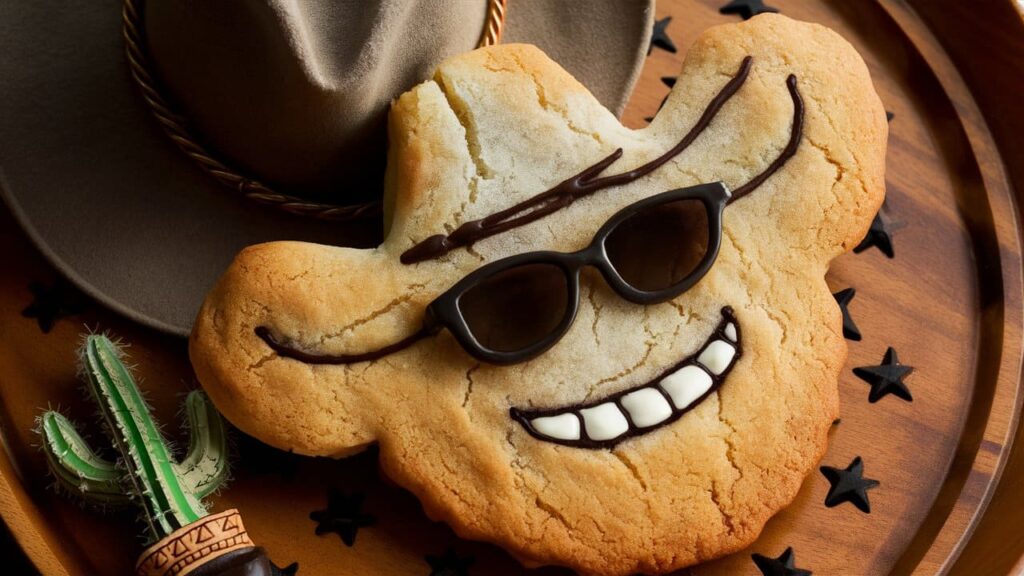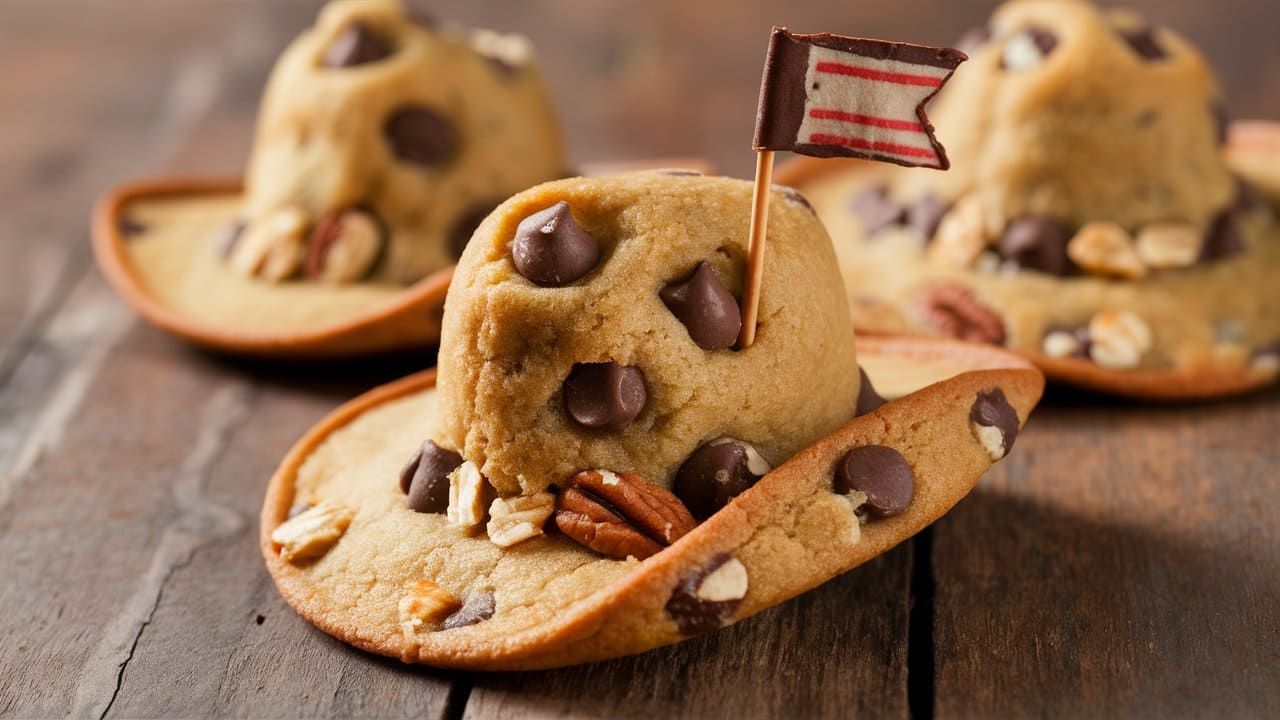The cowboy cookie is a beloved treat known for its hearty texture and rich blend of ingredients like oats, chocolate chips, nuts, and sometimes coconut. This article explores the intriguing history of the cowboy cookie, its evolution, and its enduring popularity.
The Historical Backdrop
The Early American Frontier
The cowboy cookie appears to have roots in the rugged lifestyle of the American West. It’s believed that these cookies were named after the cowboys who might have appreciated such filling and portable snacks on long cattle drives. The cookies’ high-energy ingredients were ideal for providing sustained energy in the harsh conditions of the frontier.
Evolution of the Recipe
Originally, the cowboy cookie was a simple concoction made from whatever staples were available, which often included flour, sugar, eggs, and lard. Over time, as ingredients like chocolate chips and oats became more accessible, they were incorporated into the recipes, transforming these cookies into the richer and more diverse treats we know today.
Popularity During the Great Depression
During the Great Depression, the cowboy cookie became popular as a budget-friendly option that could feed many mouths. Its affordability and the ability to stay fresh for extended periods made it a practical choice during those challenging times.
Key Ingredients and Their Significance
Oats: The Staple of Sustainability
Oats are not only filling but also offer sustained energy, which was essential for cowboys and pioneers during long days of physical labor.
Chocolate Chips: A Sweet Evolution
The introduction of chocolate chips into cowboy cookies marked a significant evolution in their recipe. Initially a luxury, chocolate chips became widely popular in America after the invention of chocolate chip cookies in the 1930s. Their inclusion in cowboy cookies added a much-loved sweetness and richness.
Nuts and Coconut: The Crunch Factor
Nuts and coconut are optional but popular additions that give cowboy cookies their distinctive crunch and flavor depth. These ingredients also enhance the nutritional profile of the cookies, adding healthy fats and proteins.
The Cowboy Cookie in Modern Times
Cultural Impact and Continued Popularity
Today, the cowboy cookie enjoys a nostalgic and cultural significance in America, often associated with traditional values of simplicity and hardiness. Its popularity persists, with variations of the recipe passed down through generations and featured in cookbooks and baking contests.
Variations and Personal Touches
The versatility of the cowboy cookie recipe allows for numerous variations. Bakers often add personal touches, such as different types of nuts, various spices, or even a hint of bourbon, to tailor the cookies to their tastes or to make use of available ingredients.
Cowboy Cookies in the Digital Age
In the digital age, the cowboy cookie has found a new audience online. Food bloggers and home bakers share their unique takes on the classic recipe, ensuring that the cowboy cookie continues to evolve and adapt to modern tastes and trends.
# Contemporary Significance and Cultural Adaptations
Recipe Innovations and Variations
Health-Conscious Adaptations
As health trends evolve, so do the recipes for traditional treats like the cowboy cookie. Many bakers now opt for substitutions that cater to health-conscious consumers, such as using whole wheat flour, reducing sugar, or incorporating vegan ingredients like flax eggs and coconut oil.
Gourmet and Artisanal Variations
Gourmet versions of the cowboy cookie have also surfaced, with high-end ingredients like dark chocolate chunks, imported nuts, and artisanal sea salt. These premium variations cater to a more refined palate while maintaining the hearty essence of the original recipe.
Global Influences
The cowboy cookie has also embraced global influences, integrating ingredients like matcha, chai spices, or dried exotic fruits. These adaptations not only highlight the cookie’s versatility but also its ability to merge different culinary cultures.
Social and Community Impact
Fundraising and Charity Events
Cowboy cookies are a popular choice for bake sales and fundraising events. Their appeal and ease of preparation make them an effective tool for raising money for schools, community projects, and charities.
Educational Programs and Cooking Classes
Cooking classes often feature cowboy cookies to teach basic baking skills and the importance of measuring and mixing. These classes promote the idea of baking from scratch, emphasizing skills that can be applied to a variety of recipes.
Cultural Celebrations and Festivities
In some regions, cowboy cookies have become part of holiday traditions and cultural celebrations. They are often included in festive gift baskets or as part of a dessert spread during community gatherings and family reunions.

The Role of Cowboy Cookies in Modern Cuisine
Comfort Food and Nostalgia
In contemporary cuisine, the cowboy cookie is often celebrated as a comfort food, evoking nostalgia and a sense of warmth. Its rustic appearance and rich texture remind people of home cooking and traditional values.
Presence in Cafes and Bakeries
Many cafes and bakeries feature cowboy cookies as a staple item, appealing to customers looking for a hearty snack that pairs well with coffee or tea. This widespread availability helps maintain the cookie’s popularity across different age groups and demographics.
Media and Pop Culture
The cowboy cookie has also made appearances in media and pop culture, including television shows, online series, and podcasts discussing baking and American traditions. These appearances help keep the cowboy cookie relevant in the public eye.
The Role of Cowboy Cookies in Culinary Education and Media
The cowboy cookie not only serves as a treat but also plays a significant role in culinary education and media, reflecting broader themes of tradition, innovation, and cultural exchange.
Culinary Education and Cowboy Cookies
Teaching Traditional Baking Techniques
Cowboy cookies are frequently used in culinary courses to teach traditional baking techniques. Instructors emphasize the importance of proper ingredient measurement, mixing methods, and baking times, which are crucial for achieving the perfect texture and flavor profile.
Highlighting Ingredient Functions
These cookies provide an excellent opportunity to discuss the role of various ingredients in baking. For example, educators might explain how oats help retain moisture, creating a chewy texture, or how the fats from nuts and butter contribute to the richness of the cookie.
Fostering Creativity and Adaptation
In more advanced classes, students are encouraged to modify the classic cowboy cookie recipe. This exercise teaches budding chefs how to adapt recipes based on available ingredients, dietary restrictions, or flavor preferences, fostering creativity and problem-solving skills in the kitchen.
Media Representation of Cowboy Cookies
Features in Cooking Shows and Blogs
Cowboy cookies often feature in cooking shows and food blogs, where they are praised for their robust flavor and versatility. These platforms provide step-by-step recipes, baking tips, and innovative variations that keep the cowboy cookie relevant in contemporary culinary discourse.
Discussions in Food Podcasts
Food-themed podcasts sometimes delve into the history and cultural significance of traditional treats like cowboy cookies. These discussions can provide listeners with a deeper appreciation of the cookie’s roots and its evolution over the years.
Social Media Trends and Challenges
On platforms like Instagram and Pinterest, cowboy cookies have become part of baking challenges and social media trends. Users post pictures of their homemade versions, share recipes, and tag friends to spread the love for this hearty, delicious cookie.
The Future of Cowboy Cookies
Sustaining Interest Through Innovation
As culinary trends continue to evolve, the future of the cowboy cookie looks promising. Bakers and chefs will likely continue to innovate, incorporating new ingredients and techniques while still honoring the cookie’s rustic origins.
Maintaining Tradition in Modern Baking
Despite changes and trends, the essence of the cowboy cookie as a symbol of comfort and home cooking remains strong. Its enduring appeal lies in its simplicity and the nostalgic connection it evokes, ensuring it remains a staple in both home kitchens and professional bakeries.
Educational Tool in Global Culinary Practices
The cowboy cookie serves as a bridge between traditional American baking and global culinary practices, making it a valuable educational tool. It exemplifies how a simple recipe can adapt to incorporate global influences, thereby promoting cultural understanding and appreciation through food.
Cultural Significance and Global Reach of Cowboy Cookies
The cowboy cookie serves as a symbol of American culinary heritage, yet its influence and popularity extend far beyond the United States, demonstrating its global appeal and adaptability.
Cultural Significance of Cowboy Cookies
An American Icon
The cowboy cookie embodies the spirit of the American West—rugged, resourceful, and robust. It reflects the historical narrative of American pioneers and cowboys who required nourishing and durable food items during long cattle drives and journeys across the frontier. This historical association adds a layer of cultural depth and significance to the cookie, making it a unique part of American culinary tradition.
Symbol of Comfort and Home Cooking
Cowboy cookies are often associated with comfort and warmth. In many homes, they are baked during holidays, family gatherings, and festive occasions, making them part of cherished culinary traditions. The smell of cowboy cookies baking in the oven can evoke strong feelings of nostalgia and comfort, connecting generations.
Representation in Literature and Film
The cowboy cookie has made appearances in various forms of literature and film, often used to symbolize American ingenuity or the simple pleasures of life. Its inclusion in these media forms helps to cement its status as a cultural icon, not just a culinary one.
Global Reach and Adaptation
International Variations
As the cowboy cookie has traveled beyond American borders, it has been embraced and adapted by different cultures. In some countries, local ingredients like local nuts, indigenous fruits, or regional spices are added to give the cookies a distinct local flavor that reflects the tastes and agricultural products of the area.
Popularity in Cafes and Bakeries Worldwide
Internationally, cowboy cookies can be found in cafes and bakeries around the globe, appealing to a wide audience with their hearty texture and rich flavors. Their global presence in popular coffee chains and small local bakeries alike speaks to their universal appeal.
Featured in International Culinary Competitions
Cowboy cookies are also featured in international baking and culinary competitions, where they are appreciated for their rustic charm and adaptability. Competitors often put unique spins on the classic recipe, showcasing global culinary influences and innovation.

Future Perspectives
Continued Evolution Through Global Cuisines
The cowboy cookie is likely to continue evolving as it becomes incorporated into global cuisines. This evolution will not only include new flavors and ingredients but also different cooking methods and presentations that reflect international culinary trends.
Role in Promoting Cross-Cultural Exchange
By adapting cowboy cookies to include global influences, bakers and chefs contribute to a broader dialogue about food and cultural exchange. These adaptations can serve as a gateway for people to explore and appreciate other cultures through their culinary traditions.
Educational and Inspirational Role in Baking
The ongoing popularity and adaptation of cowboy cookies serve as an educational tool and inspiration for both amateur and professional bakers worldwide. They exemplify how traditional recipes can be adapted over time and across cultures, maintaining their essence while embracing innovation.
The Legacy and Continued Relevance of Cowboy Cookies
As we delve deeper into the significance of the cowboy cookie, it becomes clear that this iconic treat is not only a part of American culinary history but also a living tradition that continues to adapt and inspire across generations and borders.
The Educational Value of Cowboy Cookies
Teaching Historical Contexts
Cowboy cookies offer a unique opportunity to educate people about American history, specifically the era of the Western frontier. Baking these cookies can serve as a gateway to discussions about the lifestyle, challenges, and dietary habits of early American settlers and cowboys.
Culinary Skills Development
In culinary education, cowboy cookies are used as a practical example to teach various baking skills. These include the creaming method for combining butter and sugar, the importance of dry ingredient ratios, and the effects of different baking temperatures and times on the final product.
Nutritional Education
Educators also use cowboy cookies to discuss nutrition. Ingredients like oats and nuts provide a good opportunity to talk about energy-dense foods that are beneficial for sustained physical activity—echoing the needs of the cowboys for whom these cookies were originally intended.
Media and Promotional Use
Marketing and Promotion
In the commercial realm, cowboy cookies are often featured in marketing campaigns that emphasize tradition, nostalgia, and hearty ingredients. This marketing approach appeals to consumers’ desire for authenticity and quality in their food choices.
Social Media Influence
On social media, cowboy cookies have become popular not just for their taste but also for their aesthetic appeal. They are often featured in posts, blogs, and videos, highlighting both traditional recipes and innovative twists that attract likes, shares, and comments.
Television and Print
Cowboy cookies also appear in cooking shows and print media, where they are often used to illustrate themes of American cooking or holiday baking. These appearances help to maintain their popularity and relevance in modern culinary culture.
Legacy and Future Outlook
A Symbol of American Resilience and Innovation
The cowboy cookie stands as a symbol of American resilience and the ability to innovate with available resources. This spirit resonates with contemporary audiences, especially in times when adaptability and resourcefulness are celebrated qualities.
Global Cultural Exchange
As cowboy cookies continue to incorporate ingredients and techniques from around the world, they become a symbol of cultural exchange and culinary fusion. Each new version tells a story of cross-cultural connections and shared culinary appreciation.
Continued Popularity and Adaptation
Looking ahead, the cowboy cookie is poised to remain a beloved treat worldwide. Its ability to adapt to changing tastes and dietary needs will ensure its place in both home kitchens and professional bakeries for generations to come.
Conclusion
The cowboy cookie, with its rich history and robust flavor, is more than just a snack; it’s a cultural artifact that continues to evolve and resonate across the globe. From educational tools to social media trends, cowboy cookies embody a tradition that celebrates American history while embracing global influences. Their enduring popularity underscores a universal love for flavors that not only satisfy the palate but also enrich the soul. As we reflect on the journey of the cowboy cookie, it is clear that its legacy is built on a foundation of adaptability, resilience, and continual reinvention, making it a timeless icon in the world of baking.
You can get more recipes from here:

